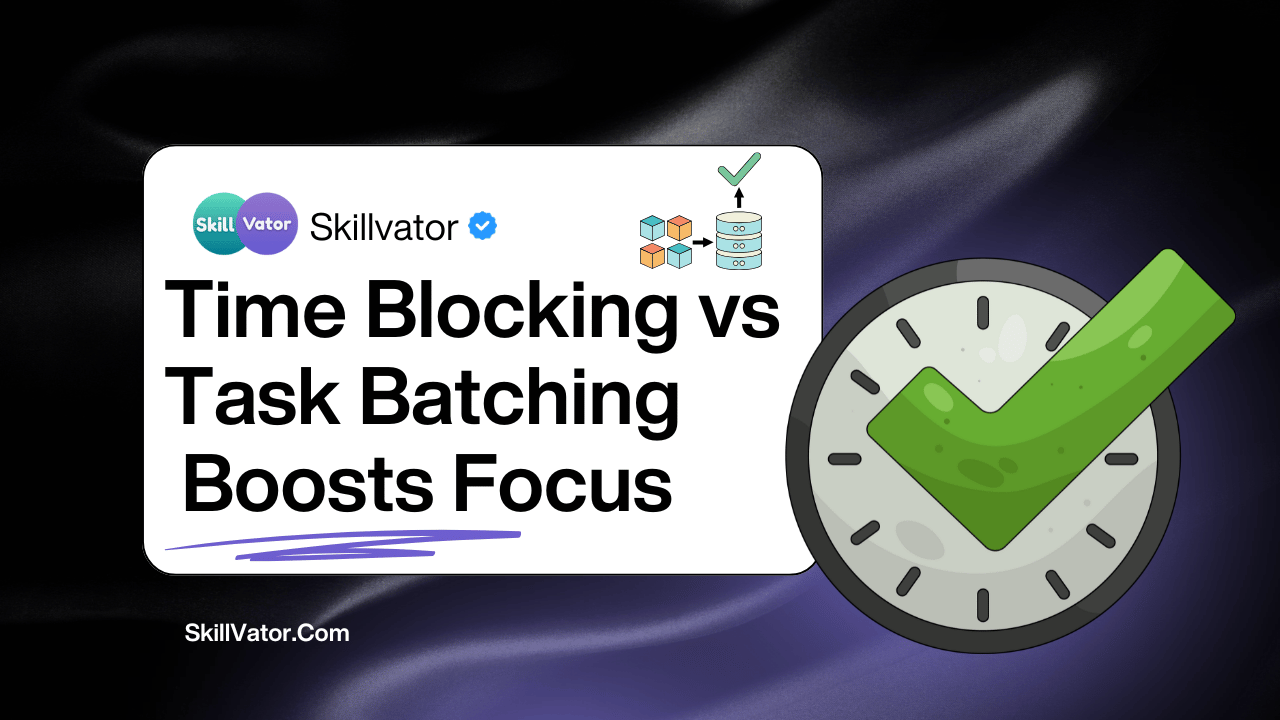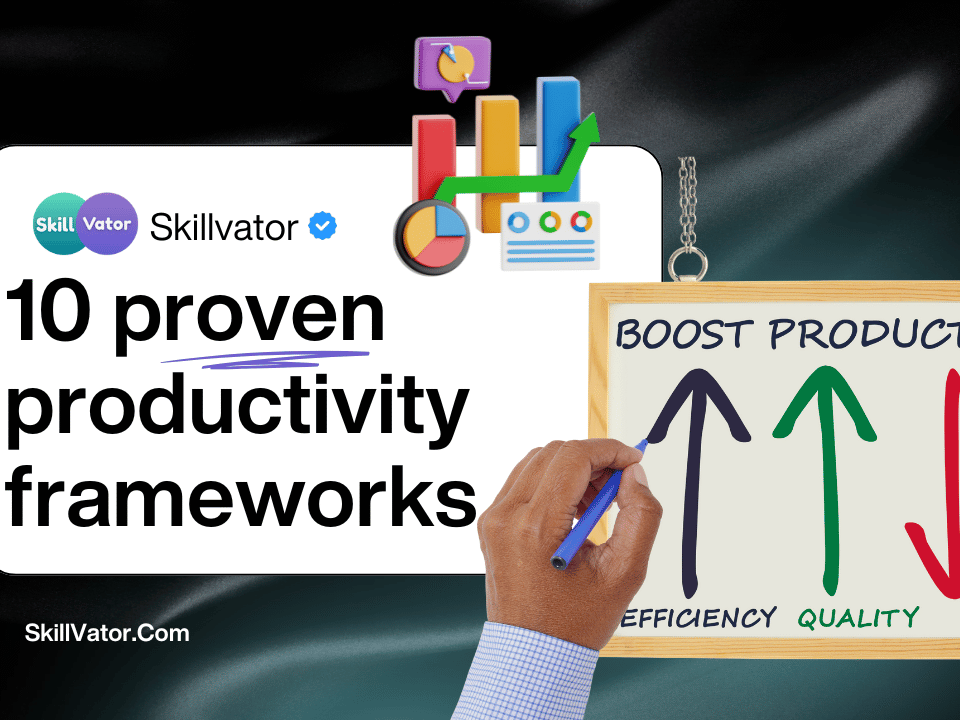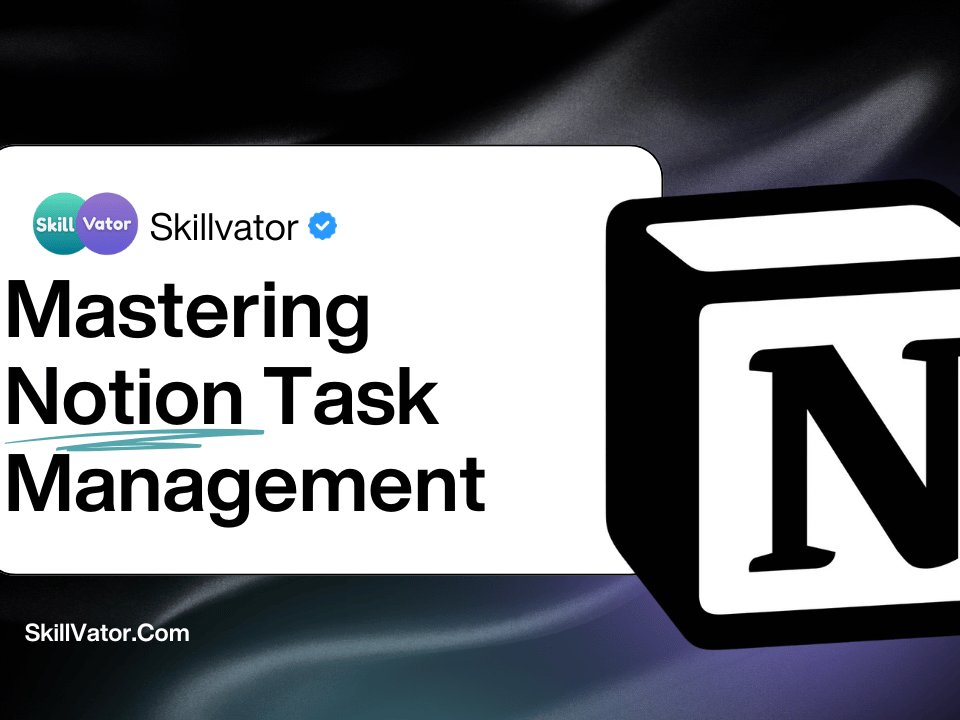In today’s fast-moving digital world, focus has become one of the most valuable professional currencies. Notifications, emails, and endless multitasking can easily scatter your attention and drain your energy.
At Skillvator, we believe that working smarter—not just harder—starts with mastering how you structure your time. Two of the most popular strategies for optimizing productivity are Time Blocking vs Task Batching.
Both methods promise better focus, fewer distractions, and higher efficiency. But which one truly helps you get more done without burning out? Let’s explore their differences, benefits, and how to choose the right one for your workflow.
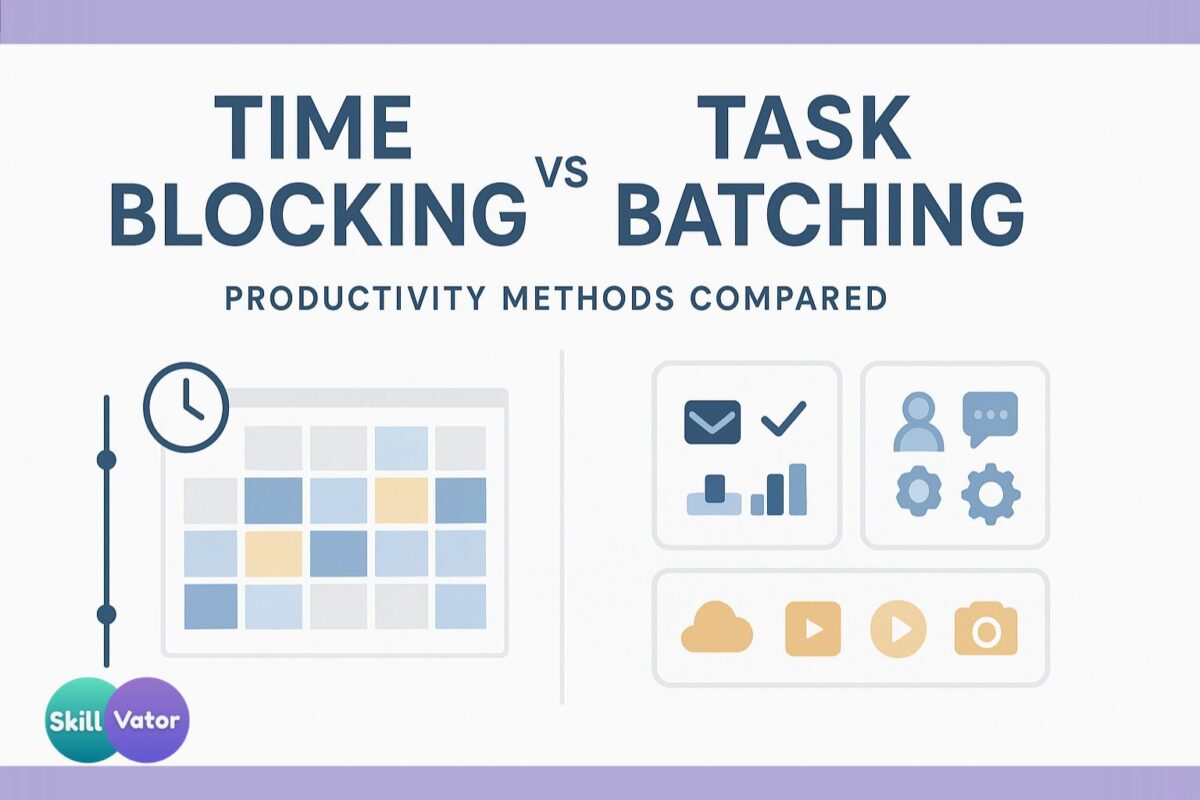
What Is Time Blocking?
Definition
Time Blocking is a time management method where you divide your day into blocks of time, each dedicated to a specific task, project, or type of work. Instead of having a never-ending to-do list, you assign each task a precise time slot.
It’s a structured system that forces you to prioritize what really matters.
How Time Blocking Works
-
List your tasks for the day or week.
-
Estimate how long each task will take.
-
Assign time blocks in your calendar for each task.
-
Work on only that task during its assigned time.
-
Review and adjust your blocks as you go.
A simple example:
| Time | Task |
|---|---|
| 8:00–9:30 AM | Deep Work – Content Writing |
| 9:30–10:00 AM | Emails & Communication |
| 10:00–11:30 AM | Team Project Planning |
| 1:00–2:30 PM | Client Work |
| 3:00–4:00 PM | Learning / Skill Development |
By structuring your day like this, you reduce decision fatigue and create protected focus zones.
What Is Task Batching?
Definition
Task Batching is a productivity method that groups similar tasks together and completes them in one focused session.
Instead of switching between different kinds of tasks, you batch related ones — like replying to all emails at once or scheduling all social media posts in one sitting.
How Task Batching Works
-
Identify repetitive or similar tasks.
-
Group them into categories (e.g., admin, creative, communication).
-
Schedule a time to complete each batch.
-
Stay in the same cognitive mode while working through the batch.
Example:
| Task Category | Batched Session |
|---|---|
| Emails & Messages | Monday, 10:00–11:00 AM |
| Content Creation | Tuesday, 2:00–5:00 PM |
| Meetings & Calls | Wednesday, 1:00–4:00 PM |
| Planning & Review | Friday, 10:00–12:00 PM |
Batching reduces context switching, the hidden productivity killer that occurs when you rapidly move between different types of work.
The Science Behind Focus
Before comparing both methods, it’s important to understand the cognitive science of attention.
Our brains are not designed for multitasking. Every time you switch from one task to another, your brain spends up to 20 minutes refocusing. This “attention residue” leads to fatigue, lower quality work, and increased stress.
Time Blocking and Task Batching both combat this problem — but they do it in different ways:
-
Time Blocking builds focus through structured scheduling and intentional time allocation.
-
Task Batching builds focus through reduced context switching and mental momentum.
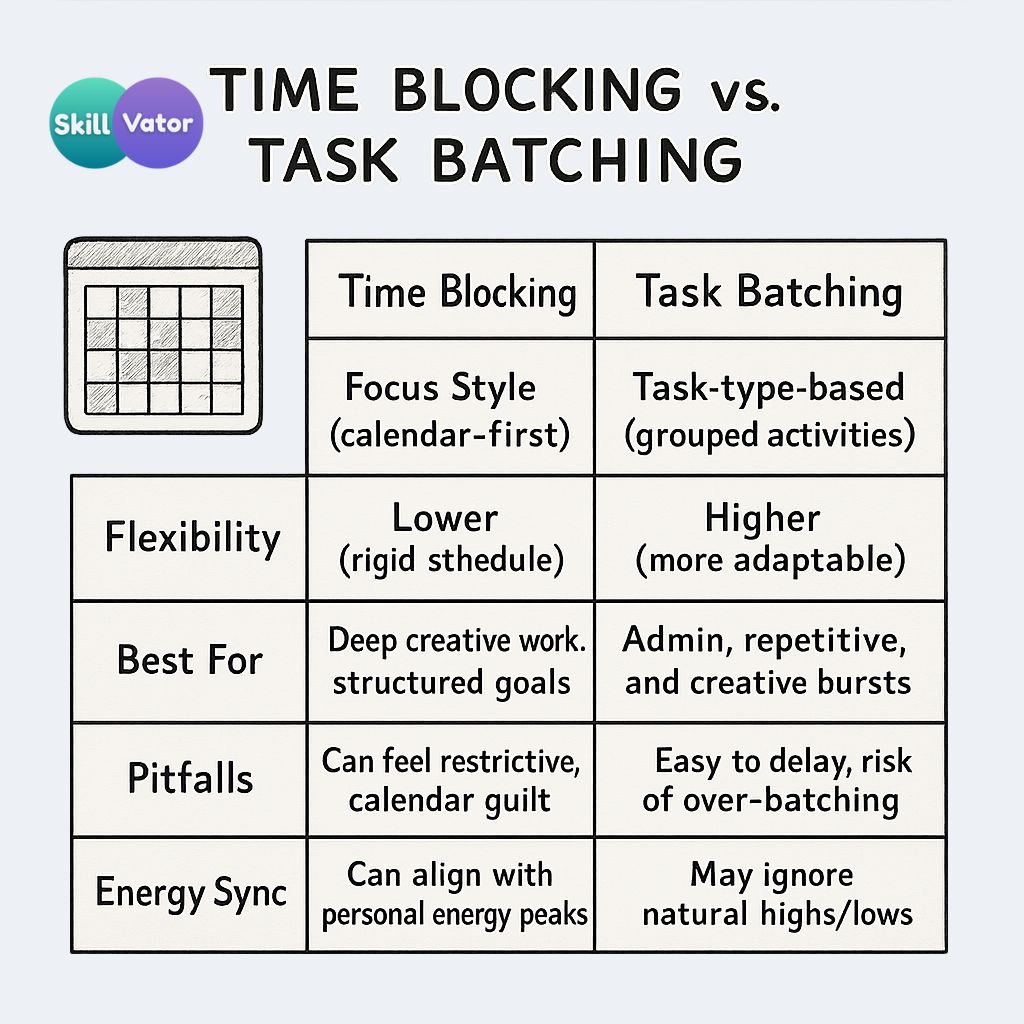
Time Blocking vs Task Batching: Key Differences
| Feature | Time Blocking | Task Batching |
|---|---|---|
| Goal | Structure the day with focused time slots | Group similar tasks to maintain flow |
| Focus Type | Time-oriented | Task-oriented |
| Best For | Complex projects, deep work | Repetitive tasks, admin work |
| Flexibility | Moderate — needs scheduling discipline | High — can be grouped anytime |
| Tool Example | Google Calendar, Notion Calendar | To-do list apps, Airtable, ClickUp |
| Downside | Overplanning can cause stress | Too much batching may delay important work |
The Advantages of Time Blocking
-
Eliminates Decision Fatigue
By pre-deciding what to do and when, you save mental energy. No more guessing “what should I do next?”
-
Improves Deep Work
Structured time blocks create uninterrupted focus periods perfect for creative or analytical tasks.
-
Makes Time Visible
You see exactly how much time you have — which improves time estimation skills and accountability.
-
Protects Your Priorities
Scheduling tasks forces you to say “no” to distractions and low-value activities.
-
Builds a Work Rhythm
Repeated time blocks for learning, planning, or execution establish a predictable workflow.
Skillvator Tip:
Combine Time Blocking with a weekly reflection session. Every Friday, review your calendar to see which blocks worked, which didn’t, and how you can optimize your focus schedule.
The Advantages of Task Batching
-
Reduces Context Switching
You stay in the same cognitive mode for longer periods, which increases mental efficiency.
-
Speeds Up Repetitive Work
Batching repetitive tasks like emails, invoicing, or design revisions minimizes setup time.
-
Improves Consistency
When you batch content creation or communication, you maintain consistency in tone, quality, and brand message.
-
Creates Mental Flow
Doing similar tasks helps your brain “get in the zone” and sustain that flow state longer.
-
Perfect for Busy Professionals
Task batching fits well into unpredictable schedules where you can’t control every hour of the day.
Skillvator Tip:
At Skillvator, we recommend pairing Task Batching with automation tools like Zapier or ClickUp Automations. You’ll amplify results by automating the repetitive parts of your workflow.
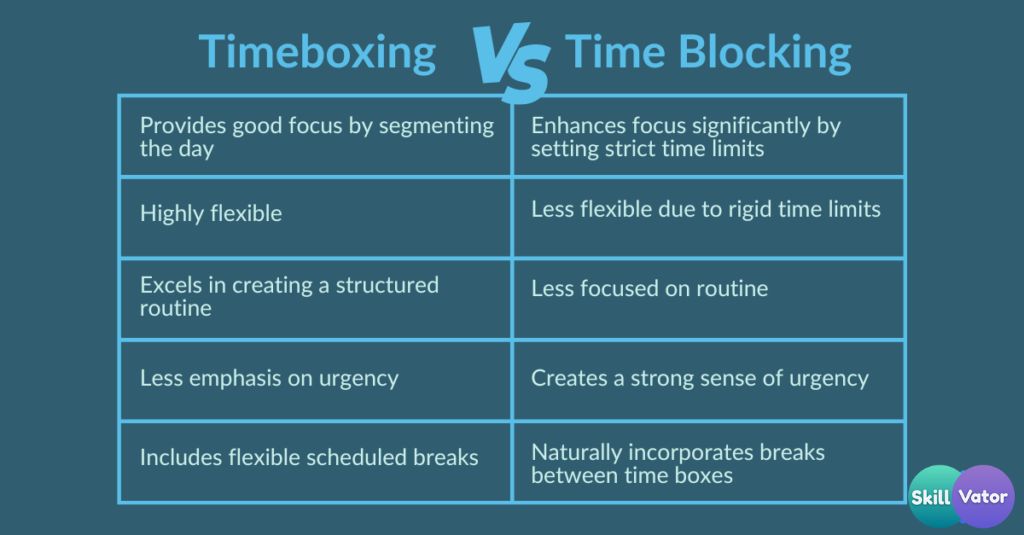
When to Use Time Blocking
Time Blocking is ideal for:
-
Deep, strategic, or creative work
-
Planning, analysis, or writing
-
Learning new skills
-
Structuring large projects with multiple milestones
-
Professionals who thrive on routine and structure
It’s particularly effective if you:
-
Tend to procrastinate without deadlines
-
Feel scattered or easily distracted
-
Want to create time for important long-term goals
When to Use Task Batching
Task Batching works best for:
-
Repetitive administrative or operational tasks
-
Responding to emails, calls, or messages
-
Creating social media content
-
Scheduling, data entry, or reporting
-
Freelancers or managers handling multiple clients
It’s a great fit if you:
-
Handle a wide variety of small tasks daily
-
Need flexibility in your schedule
-
Want to reduce the mental load of switching contexts
Combining Time Blocking and Task Batching — The Hybrid Method
The truth is: You don’t have to choose one over the other.
The most effective professionals use a hybrid system, combining the best of both.
Here’s how you can do it:
Step 1: Start with Time Blocking
Create daily or weekly blocks for specific categories like:
-
Deep Work (mornings)
-
Communication (late mornings)
-
Meetings (afternoons)
-
Learning (evenings)
Step 2: Use Task Batching Inside Those Blocks
Within your “communication” block, batch all emails, calls, and Slack messages.
Within your “creative” block, batch all writing, design, or brainstorming tasks.
This way, your calendar provides structure (time blocking), while your sessions maintain focus (task batching).
Example Hybrid Schedule:
| Time | Activity | Technique |
|---|---|---|
| 8:00–10:00 AM | Writing Blog Articles | Time Blocking + Task Batching |
| 10:00–11:00 AM | Answer Emails, Slack, Messages | Task Batching |
| 1:00–3:00 PM | Client Projects | Time Blocking |
| 3:30–4:30 PM | Admin, Invoicing | Task Batching |
| 5:00–5:30 PM | Review & Plan Tomorrow | Reflection Block |
Common Mistakes to Avoid
1. Over-Scheduling
Don’t fill every minute of your day. Leave buffer time for unexpected tasks or breaks.
2. Ignoring Energy Levels
Plan deep work during your peak energy hours, not just random times.
3. Multitasking During Blocks
Don’t mix unrelated tasks — stay true to one block’s purpose.
4. Forgetting Review Time
Without reflection, your system won’t improve. Analyze what’s working weekly.
5. Using Tools Without Intent
No tool (Notion, Asana, or ClickUp) will fix focus problems unless your habits align with your goals.
Tools to Support Time Blocking and Task Batching
| Category | Recommended Tools | Skillvator Tip |
|---|---|---|
| Calendars | Google Calendar, Outlook, Motion | Use color codes for different blocks |
| Project Management | ClickUp, Notion, Trello | Create templates for recurring batches |
| Automation | Zapier, Make (Integromat) | Automate low-value repetitive tasks |
| Focus & Time Tracking | Toggl, RescueTime, Sunsama | Track how much time you actually spend per block |
| Reflection | Notion Journal, Skillvator Planner | Review your productivity patterns weekly |
Psychological Benefits of Structured Workflows
According to research from the University of California, Irvine, it takes an average of 23 minutes to fully regain focus after an interruption. Both Time Blocking and Task Batching help prevent that loss.
They also:
-
Lower cognitive stress
-
Improve creative thinking
-
Boost self-efficacy (confidence in your ability to perform tasks)
-
Strengthen discipline and habit formation
In essence, structured work reduces chaos — freeing your mind for high-value thinking.
Real-World Example: Skillvator’s Weekly Workflow
At Skillvator, our team uses a hybrid model to maximize focus and collaboration:
-
Monday: Time-blocked for deep work and project planning.
-
Tuesday–Wednesday: Task batching for content production and SEO research.
-
Thursday: Meetings and partnership calls batched into a single day.
-
Friday: Reflection, analytics review, and creative brainstorming.
This combination keeps our focus sharp, energy balanced, and creativity high — without the burnout of constant multitasking.
The Verdict: Which One Boosts Focus Better?
The short answer: Both — depending on your work type.
-
If you deal with complex, deep-focus tasks, go for Time Blocking.
-
If your work involves repetitive or similar activities, use Task Batching.
-
If you want maximum focus and flexibility — combine both into a hybrid system.
Remember: The ultimate goal isn’t to rigidly schedule your life, but to create a rhythm of productivity that aligns with your energy and purpose.
Action Plan — How to Get Started Today
-
Audit your current week.
Identify which tasks require deep focus and which are repetitive. -
Design your calendar.
Block time for your key priorities and assign batching sessions. -
Experiment for 2 weeks.
Test, adjust, and track your focus levels daily. -
Reflect weekly.
Ask: What worked? What distracted me? -
Optimize continuously.
Productivity is not a destination — it’s a practice.
Conclusion: Focus Is a Learnable Skill
In an age where attention is fragmented, mastering your time is your superpower.
Both Time Blocking and Task Batching offer practical, evidence-backed methods to reclaim your focus and boost performance.
At Skillvator, we teach professionals and creators to elevate their workflow, build smarter habits, and create fulfilling, balanced careers. Whether you’re managing a team, freelancing, or growing your business — your time is your greatest asset.
So, start today.
Block your time. Batch your tasks.
And let Skillvator guide you toward working better, growing faster, and living smarter.



